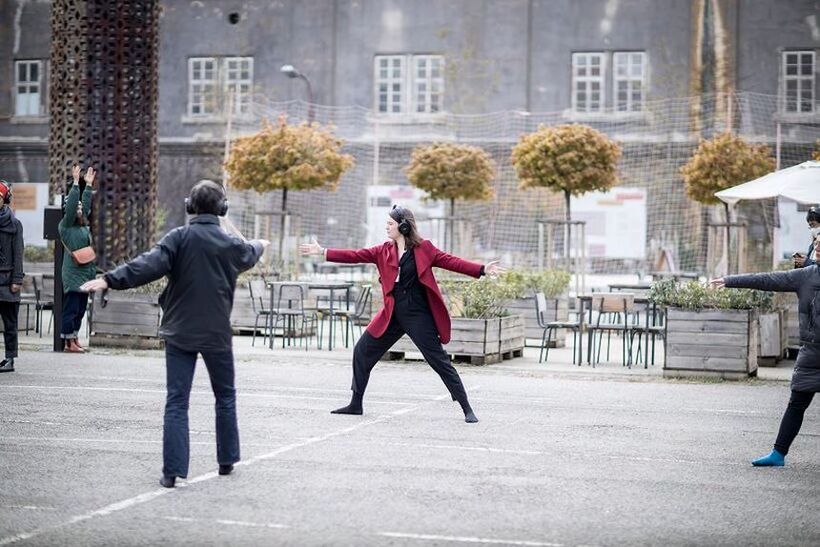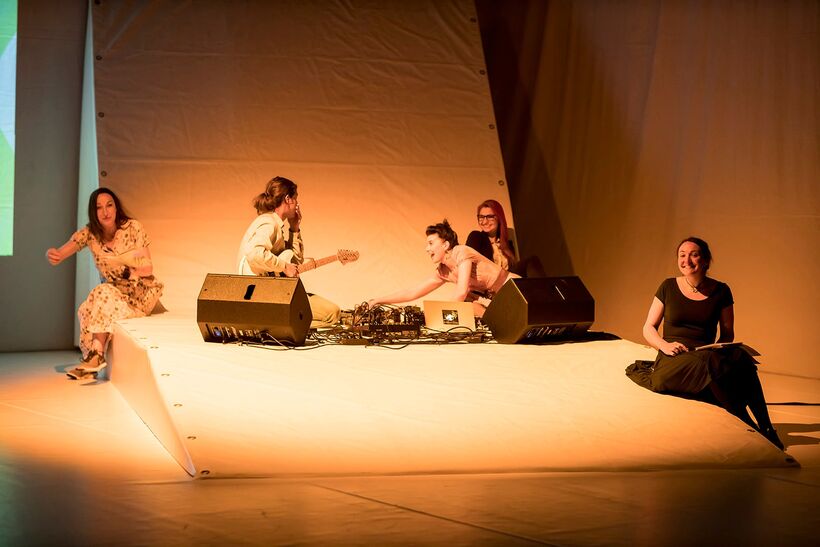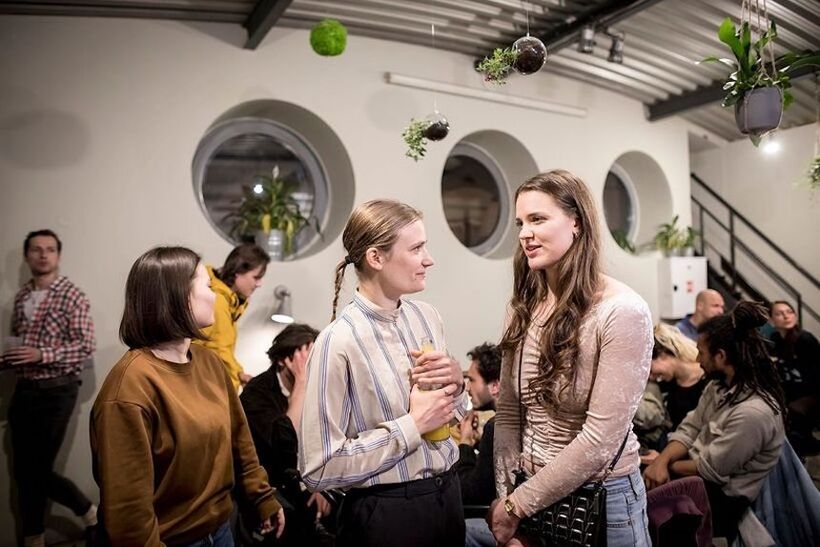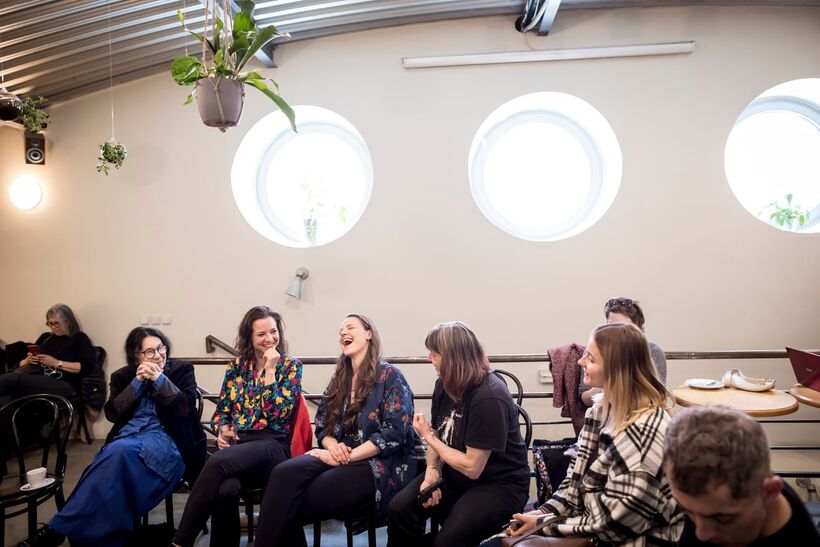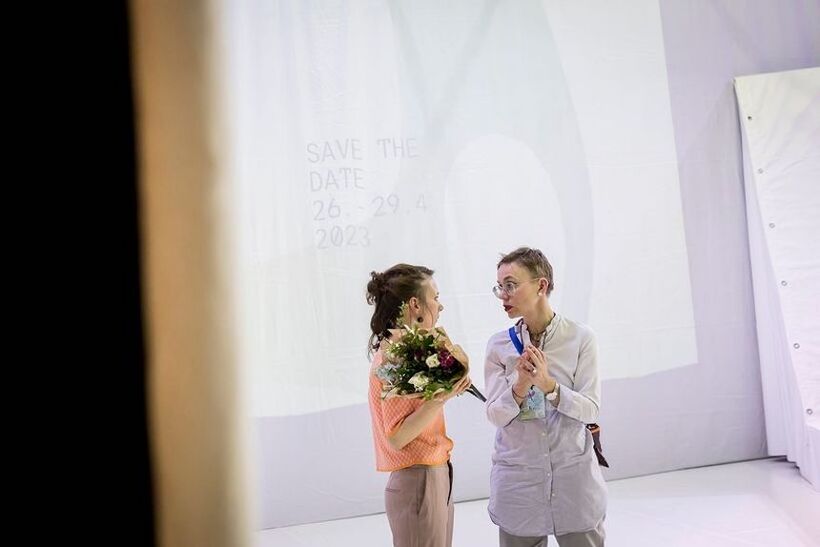Czech Dance Platform is European
The Czech Dance Platform (CDP), which took place in Prague from 24th to 26th April , presented once again a selection of local contemporary dance productions. It is a festival like no other in the course of three days, the CDP showcased nine works selected by a programming council consisting of critics, dramaturges, theorists and festival directors. Also young critics (students of arts programmes at Czech and Slovak ) had their say within the Be SpectACTive project! The council can only choose from works and artists registered for to the platform – this year, it was above forty subjects. The final selection is then presented to the audience of mainly professionals from the European, as well as global art scene.
The platform format is very popular among the foreign producers, as it allows them to see the local production in a condensed form and discover new works and artists, they can later invite to their theatres, residential spaces, or festivals. This proved successful in the past and helped some Czech and Slovak artists (e.g. Tereza Lenerová, Martin Talaga, Tereza Ondrová or Peter Šavel) present their work abroad. The attention and feedback from foreign professionals help Czech artists gain more confidence, which results in their regular presence at the renown European dance platform Spring Forward, organized by the Aerowaves network.
This year’s CDP was preceded by a discussion about the legitimacy and the process of selecting works for the platform, but also about the amount of subsidies the festival receives form the public budget. As a former member of the council for the year 2020/2021, I can only state that I and my fellow council watched responsibly all the registered works, we discussed each of them thoroughly and then voted on how much we wished the production to be included into the final selection. The talks were inspiring and though-provoking, and I certainly did not feel pushed into any kind of decision. When selecting the works, the council evaluated such aspects as the quality of a piece, execution, theme, potential for the European audience (because the goal of the festival is to promote Czech dance to the world) and also the possibility of international touring. Furthermore, the subject of genre diversity was tackled to avoid emphasising, only one type of work or aesthetic concept. The result is a compromise among votes of people with very different personalities, diverse professions and aesthetic sensibilities. I believe that the same process happened this year, and the nine selected works were indeed strongly diversified.
Infinite variety of choices
This year, I did non only find it highly interesting to watch all the performances, but also – and perhaps even more – to listen to debates around the works, conducted by the Slovak dramaturge Maja Hriešik and British critic Emily May. The format called the ‘Art of Dialogue’ took place every day around noon and it treated the works. Such initiative can really only be organized during a festival of this type, where everybody sees more or less the same performances, and is willing to come the day after and share their opinion. Furthermore, the participants were mainly professionals – theatre and festival directors, producers, artists and critics – who in a certain way steer the direction of the genre and form the public taste. Here we come to understand in how many different ways the same work can be perceived and what can be found in it based on their own spectatorial and personal experience. For me, personally, it was an opportunity to realise, once again, how much space contemporary dance offers us, both in terms of expression and perception. That is its beauty and power. Moreover, the discussions illuminated the impossibility of objectively selecting “the best of”, or even “the most interesting of” the Czech dance. Everything depends on perspective and discussions between concrete people gathered for the purpose of making the choice. Similar “problems” and exchanges of ideas surely occur during the above-mentioned festival Spring Forward, a selection of 21 contemporary dance works from all around Europe. I had the opportunity to visit this festival twice, once in person, once virtually, and even there I was not constantly excited about the works I got to see.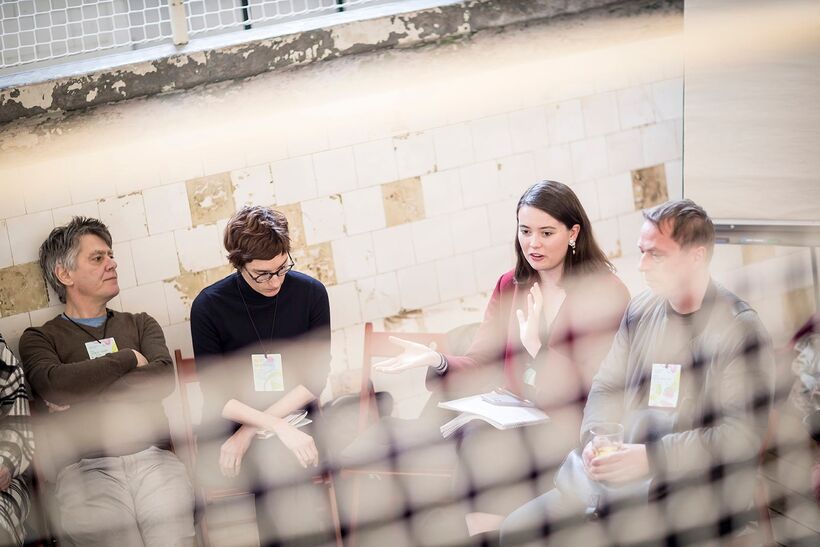
Finally, many could be surprised by the results announced by the the CDP’s international jury, who can hardly be accused of manipulation. The jury members came from Germany, Hungary, Norway, Italy and Cyprus, so literally from all the corners of Europe, from countries with very different political and artistic development.
This year, the jury presented not one, but three main prices. They awarded works “which resonated the most and expressed high quality and diversity of the Czech dance scene”: dis pla y by Jitka Čechová and Tereza Lenerová, Call Alice by Tereza Ondrová a Francesca Foscarini and Celestial Odyssey by Andrea Miltnerová, Monika Knoblochová and Jan Komárek. The Czech Centres award for a remarkable personality of CDP went to Lucia Kašiarová and her production of Multividual, and the harpsichord player Monika Knoblochová received a special mention of the jury, for her “ cosmic concert for the eyes” in Celestial Odyssey.
One could ask: How come one of the main prices went to a “non-dancer”?! But isn’t it beautiful that dance professionals were so enthralled by this musician’s impeccable performance that they decided to award her such a prize?
Listening to dancers and watching music
Putting aside the awards, what did the Czech Dance Platform tell us about Czech dance? In terms of the traditional stylistic and thematic diversity, a few overlaps and recurring aspects could be spotted this year.
One of them was lighting design – many spectators appreciated its sophistication, professionalism, and effectiveness within a work of art. Particularly striking examples were Věra Ondrašíková’s Witness (lights by Pavel Kotlík), Johana Pocková’s To the Madonna with Rust (lights by Jiří Šmirk), Lucia Kašiarová’s Multividual (lights by Štěpán Hejzlar), Sylva Šafková’s INspiraCe (lights by Anna Chrtková), Andrea Miltnerová’s Celestial Odyssey (lights by Jan Komárek) and Martina Talaga’s Sarx (lights by Karel Šimek).
The jury member Anikó Racz from the Hungarian arts and cultural centre SÍN pointed out that in this respect, Czech dance is far ahead of the Hungarian one. The latter still struggles with problems regarding the space, finances and time for rehearsing, and therefore the possibilities for working with lighting design is limited.
Given the number of works featuring exquisite light design, it might seem odd that no prize was awarded in this field this year, even though it has been handed out at the festival by the Institute of Lighting Design for the past eleven years. The Institute’s representative Jan Rolník justified the decision by stating that the community of lighting designers had decided to reflect the work within the field in a different way. The creators do not wish to stand “in the spotlight” themselves. Originally, the purpose of the award was to emphasize the importance of light design in the domain of performing arts, but this mission is now considered complete. As a next step, they would like to open a more sophisticated discussion about lighting design, through written and spoken reflections of individual works. Therefore, a series of texts by Ukrainian arts students covering the CDP’s lighting design will be published this year as a form of feedback for the designers, and live discussions are set to take place in the coming years. This seems to be an inspiring development, which might be also applied in costume design – an area which is still quite underrated and barely spoken (written) about in the Czech milieu.
Another recurring motif at the CDP was the use of spoken word; in several works, the dancers talk to the audience through their voices rather than through their bodies. That was especially the case of Silent and Call Alice by Temporary Collective and Tereza Ondrová, respectively, Multividual, dis pla y and To the Madonna with Rust, in which we could hear Johana Pocková’s beautiful singing.
Besides the voice, some artists decided to share the stage with live musicians and integrate various musical instruments, which also intrigued the spectators. The British critic Sanjoy Roy noted: “It was great to hear and see composed music incorporated into the shows with live musicians, and that composers, lighting and costume designers have clearly worked alongside the choreographer in creating works, rather than being add-ons.“ INspiraCe and Celestial Odyssey, in particular, were based on the performative potential of the musicians. In connection with the latter, a discussion opened up on the role of masks, grotesque bodies and disappearance/absence of performers. In Celestial Odyssey, the dancers were hidden behind the masks in order to create an extraterrestrial, non-human space; in Multividual, Lucie Kašiarová gradually merged with the scenography to support the idea that everything is connected; in Call Alice, one of the performers was only present through her voice, and in Silent, all performers dissapeared, while the audience was set in motion. The last two works were also directly influenced by the coronavirus, and thus related their theme of a performer’s absence, but also those of crisis and failure, which are rather universal, but regained urgency during the pandemic. However, covid was certainly not the main point of any discussion at the CDP.
As for the use of costume, the selected shows covered the whole spectrum of possibilities - from their effective connection with choreography and concept (To the Madonna with Rust) to nudity (Sarx). In reaction to an interesting debate about nudity in dance, Martin Talaga – the creator of Sarx – asked a provocative though legitimate question: “Why to use costume, when it has no special meaning in a piece?” Rather than t-shirts and sweatpants, he would have the audience watch the naked body in motion.
Other discussions addressed the role of dance in a dance piece. Contemporary choreography seems to recede from dance itself, and from style, form and technique of movement it shifts attention to the concept and performance as a whole. For instance, Lucie Kašiarová in Multividual puts the virtuosity of the piece before the virtuosity of movement alone. On the other hand, the spectators could also see works that were highly virtuoso and original in the terms of movement, for example To the Madonna with Rust and INspiraCe. And as Sanjoy Roy pointed out, this way of artistic communication still resonates with the spectator.
Foreign views on Czech dance
What impression did the foreign guests get from the CDP, and do they find any parallels between Czech dance and their home dance scene? Apart from the above-mentioned aspects, the professionals I interviewed mentioned other interesting (dis)similarities.
The artistic director of Norwegian dance festival CODA Stine Nilsen commented on the formal aspect of the works she had seen: “You have some works that are more conceptual, more abstract, with movement vocabulary that is more improvisation based, maybe more somatic, and then there are works with more stylized movement. (…) Because of my background as a dancer, I am interested in what is the material and the physicality of the body, what they chose to do, but I found that there was a range here. And there was also quite an age range in terms of performers and makers, but I did not see a strong difference between them, or a break in style. In Norway, I see even more abstract works, works that are quite bizarre, things that almost don’t make sense… and I didn’t see much of that here. I have seen more works that have text and storytelling, in one way or another, running through the works, while in Norway I don’t see as many works that use text. I don’t think dramaturgy is as common in Norway as here, but I see all the artists are using an outside eye, we are having a discussion about it, they are inviting people in.”
The director of South Korean dance festival Sidance Lee Jong-ho finds Czech (and generally European) dance more experimental than the work of South Korean artists, both movement and concept-wise. On the other hand, the audience in his country is very open, and it appreciates contemporary European works which Lee regularly brings to his festival.
André Schallenberg, the programme director of Hellerau in Dresden, thinks that in terms of topics and style diversity, there is not a big difference between Czech and German contemporary dance productions, because “many of the artists are already involved in various projects, collaborating with international artists.” During the platform, he observed a very high level of collaboration between artists, especially choreographers, lighting designers, sound designers and musicians, which he does not see that often in Germany. However, there is one major difference – it is the system of financial support, which is more advanced in Germany. And even though it is still not enough, there are opportunities for more people, there are different levels (the cities, the state, the federal government), and there are municipal theatres housing contemporary dance companies. “This is maybe also the reason why we see a lot of smaller pieces – solos, duets – at the Czech Dance Platform” says Schallenberg.
Anna Cremonini from Torinodanza (Italy) first explained that for her, each platform presents an opportunity to discover new artists as well as those who are more established but give more space to research and experiment. She stated that Czech dance creations showcased at the platform are “evidently contemporary, which is a sign of good health, because it means that this is a country which is looking ahead.” She also thinks that Czechia and Italy have much in common, because we both “carry a strong tradition on our backs, a tradition which conditions us and weights down the vision of the future. For this reason, it is very visible when the artists have the possibility of the international contacts, because thanks to that they can develop another language, which they cultivate further. The process of the so-called internationalisation is so important, for the artists to follow new approaches and expressions, but also to reject them.” She sees some similarities in creating the background for dance as well, because Italy does not invest very much into culture. Dance is the least supported discipline, which affects its development: “Both Czechia and Italy struggle to build a new generation of artists. There are not enough resources for creating more ambitious projects – in terms of form and format, but also methodology and creative process.” However, she has been witnessing some growth and development in the domain of Italian contemporary dance over the past few years, as it was given some attention and support from institutions. The international network of contacts is crucial for the development of the discipline, according to Cremonini.
Alexis Vassiliou from Dance House Lemesos (Cyprus) saw many „strong choreographic voices, different generations – older, younger, and very young“ at the CDP. He stressed the notable presence of female artists (out of ten presented works, nine were created by women), and the way they are fighting for their place in the society and the world of art. He found this movement very dynamic, brave and unapologetic, and overlapping in many points with his domestic scene. This and other similarities made him consider a future collaboration between Czech and Cypriot artists in his residency space and fostering the considerable potential.. Vassiliou also appreciated the programming and curation of the festival, the way in which its dramaturgy unfolded; not that much in the terms of the content, but rather the construction of the audience experience, the overall atmosphere, and dramaturgical arch. “I was truly amazed by the use of so many atypical venues and spaces, which was great, because we got to discover the city and visited places we wouldn’t see in other countries.” The variety and diversity of dance venues was highlighted by many foreign professionals, as a value added to their festival experience. Finally, Vassiliou emphasized the importance of the Tanec Praha organisation, whose work he has been following on a long-term basis. He considers it a high-quality, well-developed organisation that has a unique way of working with artists - accompanying them from the research phase to the final product, and engaging with them through various workshops and new projects.
From the point of view of organisation, the festival audience was well taken care of: everyone received a totebag, notebook with a pen, some small gifts, and a tag to hang around their necks which featured their name and a list of performances and venues (next time, it would be nice to include the times of performances as well). The participants had a perfect overview of their programme during the three days. They were transported between the venues by bus, otherwise it would be impossible to make it, and in order to stay well-nourished during the packed programme, their received refreshments. Such a perfect service surely contributed to the generally positive Prague experience.
Briefly, Czech Dance Platform is a unique event and its crucial role in international promotion of Czech dance cannot be denied. Whether we agree with the selection or not, however in a certain way (which will be always subjective) it does reflect the state of Czech contemporary dance, and as such it is irreplaceable on the Czech festival map. As the theatre dramaturge and critic Marta Ljubková mentioned during the final ceremony, Czech theatre certainly does not have a similar opportunity to reach foreign audiences. Czech dance (also thanks to the Platform) is getting much more attention abroad. And the effect is visible.
Written from the Czech Dance Platform 24–26 April 2022.




